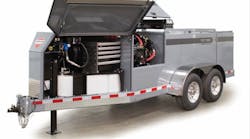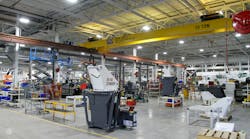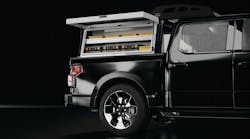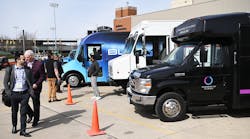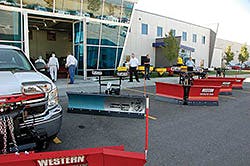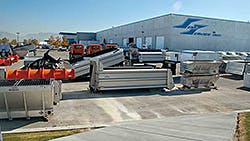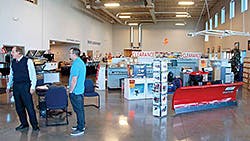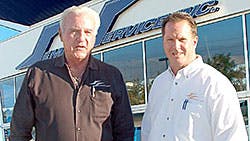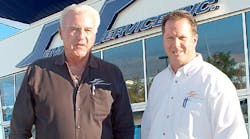WHEN the word service is part of a company name, it’s important to be able to deliver.
Semi Service Inc of Salt Lake City, Utah, has put together an assortment of services that help the company serve customers in a four-state area: Idaho, Nevada, Utah, and Wyoming—roughly a 450-mile radius around Salt Lake City.
Perhaps the most unusual service for a truck equipment distributor is the company’s compressed natural gas fueling station.
“There are about 52 CNG fueling stations in Utah,” says Tom Foulger. “Most of them are owned by the local gas company.”
The company’s new 16-acre site provides the fueling station with a distinct advantage. Located near the Salt Lake City airport, the fueling station is convenient to an array of shuttle vans that run on compressed natural gas.
“In all, we fuel about 70 vehicles per day, including cars, pickups, highway tractors, and refuse trucks,” Foulger says. “Running on CNG really makes sense today. At an energy equivalent of $1.53 per gallon, the advantages of CNG are obvious—especially for fleets whose vehicles travel locally and are close to fueling stations like ours. Yes, the initial purchase price for CNG equipment is more. But if a vehicle is driven 100,000 miles per year, the payback is approximately 12 months.”
The fueling station is located on one corner of the Semi Service property, enabling even a tractor and trailer to get in and back on the road easily. The equipment pressurizes the gas to 3,600 psi, significantly higher pressure than older equipment generates. As a result, the vehicle can be refueled in three to five minutes, compared with 48 minutes that some older systems require.
The fueling station ties in nicely with another service Semi Service offers—CNG fuel conversions.
“Customers can get everything they need in one location,” Foulger says. “It makes sense. We can provide them with the conversion and upfit their chassis, all with just one stop.”
Semi Service has been offering CNG conversions for about eight years now, says Mike Anderson, vice-president.
To perform CNG conversions, the equipment supplier, IMPCO Automotive, requires that installers undergo training and are certified. Semi Service has two technicians who have trained at IMPCO headquarters and at the Semi Service facility.
Compressed natural gas presents its own set of safety concerns that the average truck equipment shop does not have to consider. It tends to dissipate easily if it leaks, but because it is lighter than air, it can accumulate in the ceiling. As a safety precaution, the Semi Service shop is equipped with a detection system that will activate the shop fans, turn off heaters, and open bay doors if gas concentrations reach a predefined level.
Helping Batman get around
Semi Service founder and president Marty Seelos has found an innovative way to promote CNG conversions. He bought one of five Batmobiles currently in existence. Semi Service installed a Corvette engine into the vehicle and converted it to run on natural gas.
The company shows the vehicle at special events in the Salt Lake City area. The Batmobile always draws attention, especially when its recessed guns rise up from their storage compartments and begin to fire. And, yes, loud popping sounds made when the guns are fired are the result of burning CNG.
“It’s a great conversation starter,” Anderson says. “We use it to help educate people about CNG as an alternative fuel.”
Promoting snowplow sales
Semi Service also had the CNG-powered Batmobile at a special promotional event the company held last fall to kick off this year’s snowplow season.
“This was the first time we tried something like this,” Anderson says. “We consider it to be a success. We sent out invitations to 500 names. We received RSVPs from 100 people, and 175 showed up.”
The open house featured displays of equipment from several manufacturers, including Buyers Products, SnowEx, and Western. Supplier personnel were on hand to answer questions.
A buffet lunch and a half dozen door prizes helped attract a crowd.
Semi Service, a company that has been in business since 1972, operates in a 108,000-sq foot facility. The company bought the property at the bottom of the recession, 2009, and completed construction of the building the next year.
“We had five shops at one time,” Foulger says. “We consolidated all but one of them into this building.
After all of the consolidation, Semi Service now has two locations in the Salt Lake City area—the flagship shop near the airport and a tank trailer repair facility about 30 miles to the north.
“It’s not that we can’t repair tanks here at our main location,” Anderson says. “We do that here, too. But the nice thing about our north location is that it is very convenient to the refineries. It’s a great place for a tank repair shop.”
Separating equipment, trailers
The new building was designed after management toured five other facilities, including two that sell both truck equipment and trailers.
“We talked to a number of people who had built new shops in recent years,” Anderson says. “We asked them what they did right and what they wish they could change. We listened and then thought about how that might apply to our situation. Then we contacted an architect.”
The building houses two shops that are built at right angles to one another. One of the shops is for trailers. The other is for truck equipment installations and service. Management agrees with what similar companies said about combining truck equipment and trailer service.
“They are two separate operations,” Anderson says. “We do both at our shop, but we keep them separate. We have two shops, separate technicians, separate supervisors. Even the accounting is separate.”
But equal. Truck equipment and trailer shops are roughly the same size, and the number of technicians in both shops is comparable. However, the design of the two shops is very different.
For example, the trailer shop has 22 service bays and a paint booth. By contrast, the truck equipment shop has 12 bays, but with a comparable amount for floor space.
“The truck equipment shop is set up like a car dealership,” Foulger says. “Trucks come in the back of the shop and leave through a door at the front. This gives us plenty of flexibility and the ability to work on 30 trucks at a time.”
No parts counters
The two shops converge at the parts warehouse. A conventional shop design would have a parts counter to serve the shop. And if we were to extend the thinking of separation of trailers and truck equipment, the building would have two counters—one for each shop. Instead, there are none.
“If we are billing our labor at $100 per hour, we don’t want technicians leaving their jobs to go get parts,” Anderson explains. “We have four people in the parts department whose duties include delivering parts to bays. They take the place of a parts counter for the shop. When one of our technicians needs a part, a parts runner takes it to him. We want our techs to stay on task.”
Semi Service employs about 50 technicians—roughly 20 in each shop, plus 10 more at its tank repair facility north of town.
The building may not have any parts counters for either shop, but that does not mean there is not one for retail customers. The shop has a lengthy counter to complement the spacious parts display area.
“We carry a lot of different lines,” Anderson says. “We are a Great Dane parts distributor. We handle tank trailer parts, CNG parts, and parts for a wide range of truck equipment. We have a 20-year parts veteran to manage the parts department for us.”
Lengthy history
Seelos started Semi Service in 1972 as a trailer repair shop. He was able to add new trailer sales a few years later.
After specializing in trailers for the first two decades, Semi Service came across its entrée into the truck equipment business. The local Fruehauf branch was up for sale—one of the Fruehauf operations that sold both trailers and truck equipment.
From that point on, the company has been broadening its equipment business. After five years of experience selling truck equipment, Semi Service obtained its first chassis pool—a GM account. The company now has bailment pools for GMC, Chevrolet, Ford, and Ram.
“We have been with GM for 15 years and 10 years with Ford,” Anderson says. “We have six years with Ram. Managing the chassis that we have in our pools is a major activity here, which is why we have a full-time chassis pool coordinator onboard.”
The company has come a long way since its early days as a trailer repair facility. And with its new facility in place, Semi Service is positioned to grow even more. ♦
______________________
WHAT THEY SELL
Semi Service is a full-line distributor. Major lines include:
Dump bodies—Henderson and Rugby
Platform bodies—Cadet, Hillsboro, Pro-Tech Industries, and Rugby.
Service bodies—Reading and Stahl.
Liftgates—Maxon, Tommygate, and Waltco.
Snow removal equipment—Henderson, Snowdogg, and Western.
Trailers—Heil, J&L Tank, Landoll, LBT Inc, Tecumseh, Trail King, TrailMax, Travis, Viking Specialized Trailers, and XL Specialized Trailers.
______________________
Click here to view all large photos and captions for Semi Service Inc
